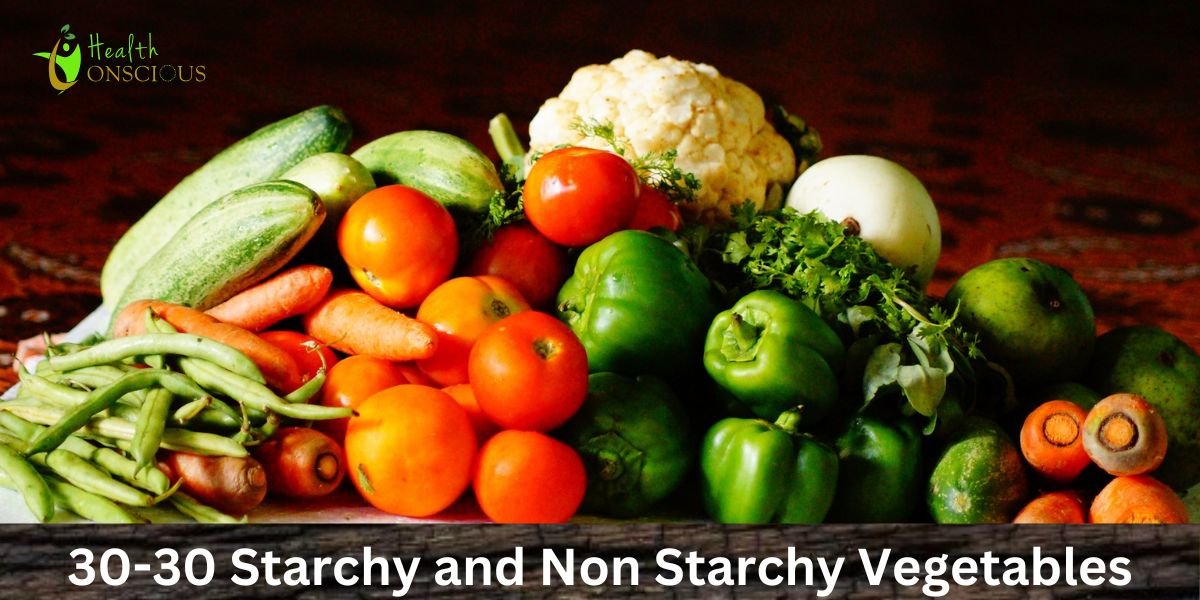Vegetables are excellent sources of many important vitamins and minerals. However, not all types of vegetables are perfect for everyone, especially those with certain medical conditions, such as diabetes or heart disease.
Vegetables, especially greens, are excellent additions to a well-balanced diet. They contain numerous vitamins, minerals, and powerful antioxidants, which are essential for maintaining a healthy body.
However, it is a beneficial idea to understand whether starchy or non starchy vegetables are best for you. Suppose you have any medical conditions, such as high blood sugar, high blood pressure, or heart problems. In that case, choosing the right vegetables can significantly improve these conditions or help you better manage them.
Understanding Starch & Its Types
Starch is a complex carbohydrate found in whole grains, legumes, and vegetables. The body breaks down long-chained glucose molecules (polysaccharides) into sugar for energy.
There are three different types of starch, depending on how the body digests or absorbs it.
- Rapidly Digestible Starch (RDS): The body can quickly break it down into sugar and absorb it in the small intestine to provide quick energy.
- Slowly Digestible Starch (SDS): The body takes a long time to break down this starch, which provides energy gradually.
- • Resistant Starch (RS): It functions similarly to fiber and evades complete digestion in the small intestine. It helps promote satiety and supports gut health.
Some starchy foods have a high glycemic index (GI), which can cause blood sugar spikes in diabetic patients. To maintain their blood sugar levels, they should consume starchy foods in moderation. However, choosing non-starchy vegetables or foods with a low glycemic index (GI) could be a beneficial option.
What Are Non Starchy Vegetables?
Non starchy vegetables are generally lower in calories and carbohydrates. However, they are abundant in essential minerals, vitamins, antioxidants, and fibers for the human body.
Also, many of these non starchy veggies have a low glycemic index, making them very helpful in controlling blood sugar levels.
Additionally, researchers suggest that vegetable-based diets can improve blood pressure and heart health and reduce cancer risks.
30 Non Starchy Vegetables List
There are thousands of species and varieties of vegetables used all over the world. However, there is a list of non-starchy vegetables:
- Artichoke
- Arugula (Rocket)
- Asparagus
- Bell Peppers (various colors)
- Bok Choy
- Broccoli
- Brussels Sprouts
- Cabbage (green, red, napa)
- Carrots
- Cauliflower
- Celery
- Collard Greens
- Cucumbers
- Eggplant (Aubergine)
- Endive
- Fennel
- Green Beans
- Kale
- Leeks
- Lettuce (various types)
- Mustard Greens
- Okra
- Onions (various types)
- Radish
- Spinach
- Swiss Chard
- Tomatoes
- Turnip Greens
- Watercress
- Zucchini (Courgette)
What Are Starchy Vegetables?
Starchy vegetables are types of vegetables rich in complex carbohydrates (starch) to provide energy for the body. The body breaks down this natural starch and converts it into sugar for fuel.
Starchy vegetables contain less but a good amount of important nutrition, including fiber, vitamins, minerals, and antioxidants. However, consuming them in moderation is the key to keeping blood sugar levels in check, particularly for diabetics. Moreover, their high-calorie content may lead to weight gain.
Some starchy vegetables contain resistant starch, which promotes the feeling of fullness and can help in weight management. Additionally, resistant starch acts as fiber in the small intestine to support the microbiome and improve gut health.
30 Starchy Vegetables List
- Acorn Squash
- Arracacha
- Arrowroot
- Breadfruit
- Butternut Squash
- Cassava (Yuca)
- Celeriac (Celery Root)
- Corn (maize)
- Delicata Squash
- Elephant Foot Yam (Suran)
- Green Bananas (unripe)
- Green Peas (mature)
- Hubbard Squash
- Kabocha Squash
- Malanga (Tannia)
- Mashua
- Oca
- Parsnips
- Plantains (especially green/unripe)
- Potatoes (white, red, yellow, etc.)
- Pumpkin
- Rutabaga
- Salsify (Oyster Plant)
- Spaghetti Squash
- Sweet Potatoes (various types)
- Taro
- Ube (Purple Yam)
- Ulluco
- Yams (true yams, Dioscorea species)
- Yautía (Tannia)
Starchy VS. Non Starchy Vegetables
| Aspect | Starchy Vegetables | Non starchy Vegetables |
| Definition | Vegetables that contain a higher amount of starch (a complex carbohydrate). | Vegetables that contain no or very little starch and are lower in carbohydrates. |
| Calories | These vegetables are higher in calories. | These vegetables are low in calories. |
| Carbohydrates | Starchy vegetables are high in carbohydrates (15–30 grams per serving). | Non-starchy vegetables are low in carbohydrates (typically less than 5 grams per serving). |
| Fiber | These contain moderate fiber content. | These contain high fiber content. |
| Glycemic Index (GI) | Generally, starchy vegetables have high GI, which can cause quick blood sugar spikes. | Nonstarchy vegetables mostly have low GI, which prevents blood sugar spikes. |
| Nutrient Density | Their nutritional content is lower than non starchy vegetables. | These a nutrient-dense and packed with many vitamins, minerals, and antioxidants. |
| Water Content | These are lower in water content. | These are higher in water content. |
| Role in Healthy Diet | Often used as a primary carbohydrate source or to add calories as an energy source in meals. | Used to add volume, fiber, and essential nutrients to meals without adding extra carbs and calories. |
| Culinary Uses | Often used as a main dish or side (e.g., mashed potatoes, corn on the cob). | Often used in salads, stir-fries, or as a side dish. |
| Weight Management | Moderation is crucial as these may contribute to weight gain if consumed in excessive amounts. | Often recommended for weight loss as a high-volume and low-calorie food. |
Benefits of Consuming Non Starchy Vegetables
Expert dietitians often recommend non starchy vegetables as healthy options. As they are nutrient-dense and contain low calories, they could be a beneficial addition to a balanced diet. Other health benefits of adding non-starchy vegetables into your diet include:
- These are best for weight management diets, as they are very low in calories.
- Because they are low in starch and most of them have low GI, they prevent blood sugar spikes.
- Non starchy vegetables have low cholesterol, thus supporting better blood circulation and heart health.
- They contain powerful antioxidants to prevent inflammation and boost metabolism. They also have been found to contain anti-cancer properties.
- These are rich in many important vitamins and minerals that support a healthy body.
- Non starchy vegetables have high water content to keep you hydrated.
- Some non-starchy vegetables, e.g., spinach, cabbage, carrots, cucumbers, etc., can be eaten raw in salads for a quick snack.



